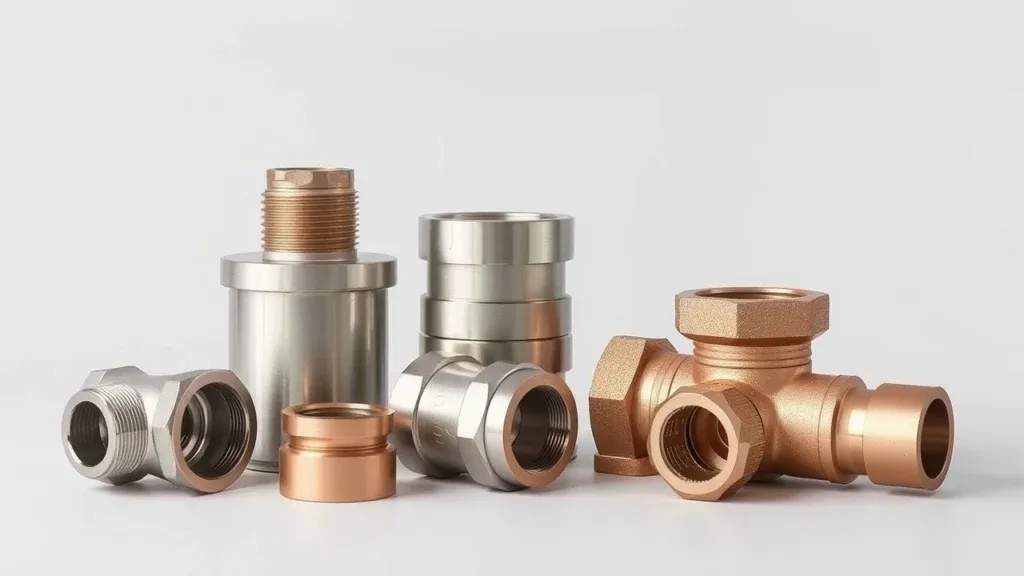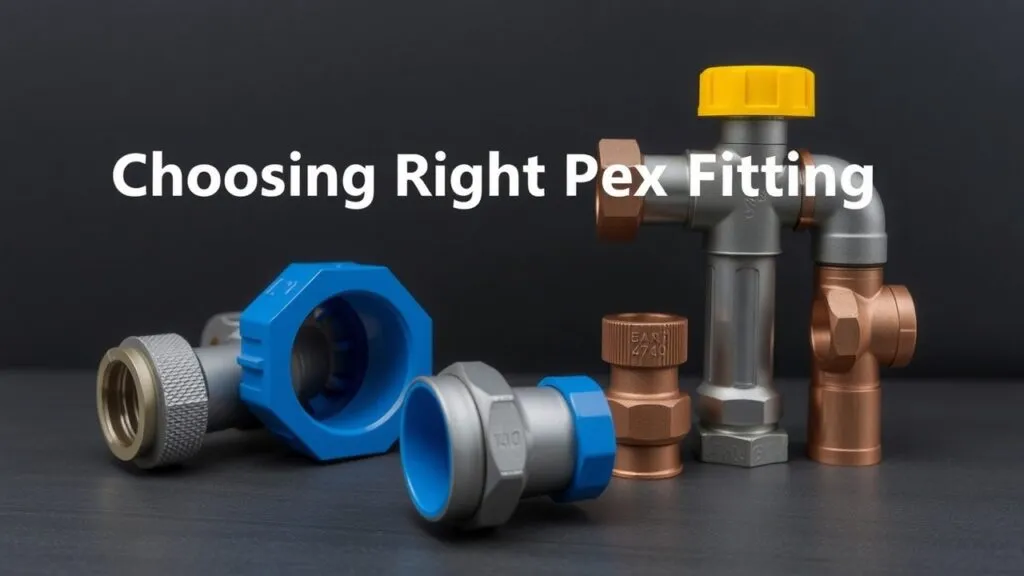There are three main types of PEX fittings: crimp, clamp, and push-fit. Choosing the right one depends on your project, skill level, and PEX tubing type.
What Are PEX Fittings and Why Are They Important?

PEX fittings are parts used in plumbing systems to connect pieces of PEX tubing. These fittings come in different types, each made for specific plumbing tasks. Knowing the types of PEX fittings is key for a good and lasting installation.
Using PEX tubing has many benefits compared to traditional materials like copper or PVC. For one, PEX is flexible. This means it’s easier to bend around corners without needing lots of joints, which can be weak points. Also, PEX resists corrosion well. It doesn’t get damaged by bad water quality as metal pipes do. Lastly, installing PEX is simple and quick; many connections can be made using just a few tools.
It’s also important to pick the right fitting for each job, whether it’s for hot water lines or areas under high pressure. Each fitting type has special features that help it work well in certain situations, making your plumbing system perform better and last longer.
Common Issues When Choosing Incorrect Fittings
Choosing the wrong fittings can cause major problems in your plumbing system. One big issue is leaks. These can happen if connections aren’t done right or if the materials don’t match well. Leaks waste water and can lead to mold and damage in your home.
Sometimes, using the wrong fitting can make the whole system fail. This means you might have to spend a lot on repairs and could be left without water for a while while fixes are made. Plus, picking the wrong fittings often leads to more maintenance needs, which adds up in costs over time.
To avoid these issues, you need to know how different types of PEX fittings work together in your plumbing setup. Make sure they’re compatible with what you already have to keep everything running smoothly.
Types of PEX Fittings Explained
When you work with PEX (cross-linked polyethylene) plumbing systems, knowing the different types of fittings is super important. Each type serves a unique purpose and has its own pros and cons. Here’s a breakdown of the main types of PEX fittings you might come across.
Compression Fittings for Flexible Connections
PEX compression fittings are made to create tight connections without needing to solder or weld. They have three main parts: a compression nut, a ring, and the body. The process is simple. You slide the ring over the tubing and then tighten the nut onto it, squishing the ring against both the tubing and the fitting body.
These fittings are great for situations where you might need to take them apart later, like repairs or changes after installation. One big plus is that they can be reused if taken care of. But watch out! If they’re not tightened just right, they can leak over time.
Crimp Fittings for Permanent Seals
Crimp fittings offer a more permanent solution compared to compression ones. They use crimp rings that go around PEX tubing, needing a special crimping tool to install them. Once crimped, these connections form strong seals that work well for hot or cold water lines.
Crimp fittings are reliable and good for residential plumbing systems under pressure. They are usually cheaper than expansion fittings, but you need to invest in specialized tools to use them.
Expansion Fittings for Professional Installations
Expansion fittings use an expansion tool that makes one end of the PEX tubing bigger so it can fit onto another piece before going back to its normal size when released from tension. This method creates strong seals that are perfect for high-pressure tasks but require skilled plumbers who know how to use this technique.
These connectors work well in projects that need fast installations because you can quickly complete multiple joints. However, getting expansion tools can be costly, so DIY enthusiasts should think carefully about this.
Push-to-Fit Connections Made Easy
Push-to-fit connections make plumbing tasks much easier! You simply push together two pieces without any special tools needed! These connectors work smoothly with different pipe materials like copper and regular PEX setups, making them user-friendly—even for beginners looking into home improvement projects.
Their simplicity is especially helpful during repairs or changes later on since no extra tools will block access points like some traditional methods do.
Compression Fittings: A Detailed Guide
How Compression Fittings Work?
PEX compression fittings are key parts in plumbing systems. They connect PEX tubing to other fixtures securely. Each fitting has three main parts: the fitting body, the compression nut, and the O-ring.
The sealing process is simple. The compression nut tightens around the tubing, which squishes the O-ring against the fitting body. This action makes a strong, watertight seal.
To install PEX compression fittings correctly, follow these steps:
- Cut the Tubing: Use a tubing cutter for a clean edge.
- Slide on Components: Put the compression nut on first, then add the O-ring before inserting the tube into the fitting body.
- Tighten Securely: Use an adjustable wrench or pliers to tighten it well but don’t overdo it. Too much force can damage the fitting or tubing.
Tools You’ll Need:
- Tubing cutter
- Adjustable wrench or pliers
Compression fittings have both pros and cons. They can be reused, making them great for repairs. Plus, they work with various pipe types.
But there are some downsides too. If not tightened properly, leaks can happen over time. You might also need special tools depending on your setup.
Installation Instructions for Compression Fittings
Getting ready to install PEX compression fittings is important. Here’s what to do:
- Cutting Tubing: Measure and cut your PEX tubing to size carefully.
- Putting It Together: First slide on the compression nut, then add an O-ring before inserting it into the fitting.
- Securing It Right: Tighten it gently with your wrench or pliers; aim for snugness but avoid being too forceful.
To avoid leaks after installation:
- Check that all parts are lined up correctly.
- Keep everything straight as you tighten; no twisting!
- Look at your connections regularly to ensure they’re still tight.
Advantages and Disadvantages of Compression Fittings
Advantages:
1. Reusability: You can take them apart and put them back together without losing effectiveness.
2. Flexibility in Disassembly: They make it easy to access pipes if you need to make changes or repairs.
3. Compatibility with Various Pipes: They work well with different types of materials beyond just PEX.
Disadvantages:
1. Potential for Leaks if Not Tightened Correctly: If installed wrong, seals can fail, causing water loss.
2. May Require Specialized Tools for Proper Assembly: Some setups need extra tools, which can increase costs.
Understanding how PEX compression fittings function helps you choose what fits your plumbing needs best!
Crimp Fittings: A Detailed Guide
How Crimp Fittings Work?
PEX crimp fittings are key parts of modern plumbing. They help connect PEX tubing safely and effectively. The main pieces in crimp fittings are the PEX pipe, crimp rings (made from copper or stainless steel), and brass PEX fittings.
The sealing works like this: First, the crimp ring goes over the end of the PEX pipe. Then, you use a crimping tool to squeeze the ring tight around the pipe and fitting. This pressure makes a strong seal that stops leaks. Here’s a diagram that shows how it all fits together:
To install PEX crimp fittings correctly, follow these steps:
- Cut the Pipe: Use a sharp cutter for a clean edge.
- Slide on Crimp Ring: Put it about 1-2 inches from the pipe’s end.
- Insert Brass Fitting: Push it into the cut end until it’s fully in place.
- Crimp with Tool: Place your crimper over the ring and squeeze firmly until you hear a click.
You’ll need some tools to do this right, like specific types of crimping tools. You can choose between manual or battery-powered options depending on what you prefer.
The good things about PEX crimp fittings are that they are affordable and durable. They create strong connections that don’t need much maintenance over time. But remember, you do need special tools to install them properly.
Different Types of Crimping Tools
When picking a tool for PEX crimps, you’ve got some choices:
- Manual Crimper:
- Pros: Cheap and easy to use.
- Cons: Takes more effort; not ideal for bigger jobs.
- Battery-Powered Crimper:
- Pros: Less work for your hands; works faster than manual ones.
- Cons: Costs more; needs charging.
- Hydraulic Crimper:
- Pros: Great for heavy-duty tasks; gives consistent pressure.
- Cons: Most expensive; takes up more space.
Choosing which tool to use depends on your project size and your experience level—manual tools might be fine for small jobs while pros often go for hydraulic models because they save time.
Budget also matters since prices can differ quite a bit at local hardware stores.
Advantages and Disadvantages
Using PEX crimp fittings comes with some clear benefits:
- They’re cost-effective compared to other methods like soldered joints or threaded connections.
- They are reliable, making them great choices for permanent installations where long-lasting results are needed.
However, there are drawbacks:
- If installed incorrectly, leaks can happen or even failures down the line. This risk goes up if someone isn’t familiar with the special tools required for installation.
Knowing these points will help you make better choices when working with PEX systems!
Expansion Fittings: A Detailed Guide
How Expansion Fittings Work?
PEX expansion fittings work by using a special process that creates strong plumbing connections. The main idea is that PEX tubing, made of cross-linked polyethylene, expands when heated. When you install these fittings, you heat the PEX tubing, making it larger. Then, you quickly insert the fitting into the expanded tubing. As the tubing cools, it shrinks back around the fitting, forming a secure seal.
Here are the key components for a good seal:
- Expansion Tool: Heats and expands the PEX tubing.
- Fitting: The piece that connects two sections of tubing.
- Sealing Mechanism: Stops any leaks once everything cools down.
The qualities of cross-linked polyethylene make these fittings effective. PEX is both flexible and strong, which makes installation easier while still holding up under pressure.
Step-by-Step Installation Instructions
Installing PEX expansion fittings is easy if you follow these steps:
- Gather Your Tools: Get your PEX tubing, expansion fittings, an expansion tool (manual or battery-powered), and safety gear.
- Cut Tubing: Use a pipe cutter to make clean cuts in your PEX tubing where you’ll install the fitting.
- Expand Tubing: Turn on your expansion tool as per the instructions and insert it into one end of your cut tubing until it’s fully seated.
- Insert Fitting: Take out the heating element from both ends before putting your chosen fitting into one end of the expanded tube.
- Let It Cool: Hold everything in place until it’s completely cooled to make sure you get a strong bond.
- Check Your Connection: After everything cools down, gently pull on both sides of the connection to check for leaks or movement before you start using water again.
Including images at each step can help guide readers better through their DIY plumbing projects.
Different Types of Expansion Tools
When picking tools for installing PEX expansion fittings, there are a few types to consider:
| Type | Description | Pros | Cons |
|---|---|---|---|
| Manual Tools | Hand-operated tools needing some effort | Cheap; easy to carry | Takes more physical work |
| Battery-Powered | Cordless tools with rechargeable batteries | Convenient; less effort needed | Can be more expensive |
| Hydraulic Tools | Uses hydraulic pressure to expand tubes | Good for bigger jobs | Heavier; may need regular upkeep |
Each type has its strengths based on what kind of project you’re working on and how you like to work with tools.
Advantages and Disadvantages
Knowing both the benefits and drawbacks of using PEX expansion fittings can help you decide if they’re right for your job:
Advantages:
- They create strong seals when properly installed since they tighten around connectors.
- They are durable under various pressures, making them ideal for things like hot water systems without worries about failure.
Disadvantages:
- You may need special tools that add extra costs which some users might not want or need depending on their project.
- If you’re new to this method, there could be a steep learning curve compared to easier methods like crimping or compression that are also used with different kinds of PEX fittings available today.
Choosing the Right PEX Fitting

Factors to Consider
When you pick PEX fittings, keep a few key things in mind. These factors will help you make the best choice for your plumbing project.
- Budget: First, look at how much money you can spend. Choose fittings that are both good quality and affordable. Spending a bit more on durable fittings can save you from leaks later.
- Skill Level: Think about your experience with plumbing. Some fittings are easier to work with than others. If you’re new to plumbing, select options that don’t need fancy tools or skills.
- Project Requirements: Decide if you need something permanent or temporary. Permanent solutions need stronger connections, while temporary ones should be easy to take apart and change later.
- Tool Availability: Make sure you have the right tools for the type of PEX fittings you choose. Crimping tools are needed for crimp-style fittings, and expansion tools are necessary for expansion-type fittings.
- Material Compatibility: Check that the PEX tubing matches your existing pipes, like brass or plastic. This is important to avoid problems like leaks or rust over time.
Decision Tree or Flowchart
Using a decision tree can make it easier to select PEX fittings based on several factors:
- Application Type:
- Residential
- Commercial
- Pressure Ratings Required:
- Low pressure (like irrigation)
- High pressure (for water supply systems)
- Compatibility with Existing Installations:
- Ensure new fittings match current piping materials
This flowchart helps you find the right fitting for your project by showing clear choices at each step.
Best Practices and Troubleshooting
Best Practices
Before you start with PEX installation, it’s super important to prep the tubing right. Make sure to deburr the ends so they’re smooth. Sharp edges can cause leaks. Cleaning the surfaces is also key for a good seal. These steps help keep things from going wrong later.
When you tighten connections, be careful not to over-tighten them. If you do, it can damage the fittings or cause leaks. Always check the torque settings that the manufacturer suggests. Properly tightened connections keep your plumbing system safe and sound.
After everything’s installed, check for leaks often. Look for wet spots around joints or places where water shouldn’t be. Finding leaks early makes repairs easier and less messy.
Safety comes first in plumbing! Always turn off the water supply before you start working. This prevents flooding or accidents. Use tools properly and wear safety gear like gloves and goggles when you need to.
Troubleshooting Common Issues
Leaks are a common problem with PEX fittings. They can happen if fittings aren’t tightened enough or if O-rings are damaged in compression fittings. If you see any moisture around your connections, fix it quickly by re-tightening or swapping out parts.
Loose connections can lead to bigger issues over time. It’s smart to check all joints regularly. If they feel loose or are wet around them, you might need to re-tighten or replace those components.
FAQs About PEX Fittings
What are the different types of PEX fittings?
PEX fittings come in various types, including crimp, compression, push-to-connect, and expansion fittings. Each type serves a specific purpose.
How do PEX barb fittings work?
PEX barb fittings connect to tubing using a barbed end. You simply push the tubing over the barb and secure it with a clamp or ring.
What are the advantages of using brass PEX fittings?
Brass PEX fittings offer durability and strength. They resist corrosion and can handle high temperatures better than some plastic options.
Can I use PEX fittings for hot water applications?
Yes, many PEX fittings are suitable for hot water applications. Always check the specifications for temperature ratings before use.
How do I install PEX expansion fittings?
To install expansion fittings, heat the tubing to expand it. Insert the fitting, then let it cool to create a tight seal.
Additional Types of PEX Fittings
- PEX Insert Fittings: These are used in conjunction with clamps to secure tubing. They fit inside the PEX tubing and provide a reliable connection.
- PEX Manifold Fittings: Manifolds distribute water to various locations in plumbing systems. They connect multiple lines efficiently.
- Copper Crimp Fittings: Copper crimp fittings provide strong connections similar to standard crimp fittings but may require specialized tools for installation.
- PEX Repair Fittings: These fittings allow you to quickly repair damaged sections of PEX tubing without needing to replace entire lengths.
- PEX Couplings and Elbows: Couplings connect straight lengths of tubing, while elbows change the direction of flow within plumbing systems.
Key Benefits of Using PEX Fittings
- Flexibility: PEX tubing is flexible, allowing for easier installation in tight spaces.
- Corrosion Resistance: Many PEX materials resist corrosion better than traditional metals.
- Easy Installation: Most types require minimal tools, making them accessible for DIY projects.
Common Tools for Installing PEX Fittings
- Crimping Tool: This tool secures crimp rings around connections effectively.
- Expansion Tool: It expands tubing when using expansion fittings.
- Tubing Cutter: A sharp cutter ensures clean cuts on your tubing for better seals.
Safety Tips When Working with PEX
- Turn Off Water Supply: Always shut off water before starting work on your plumbing system.
- Wear Protective Gear: Use gloves and goggles while handling tools and materials to prevent injuries.
Related Topics
- types of PEX expansion tools
- types of PEX repair fittings
- types of PEX manifold fittings
- types of PEX couplings
- types of PEX elbows



Types of PEX Fittings: A Guide to Crimp, Clamp, & Push-Fit Connections